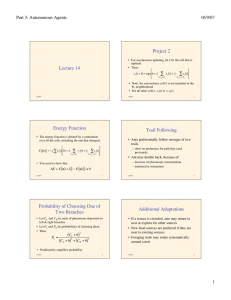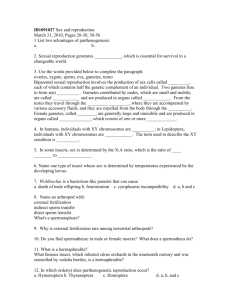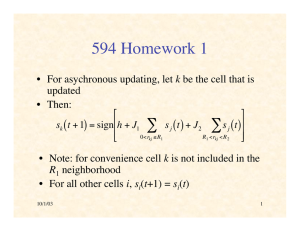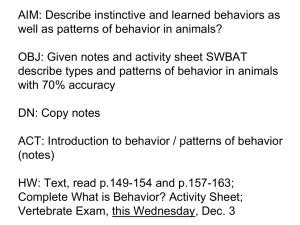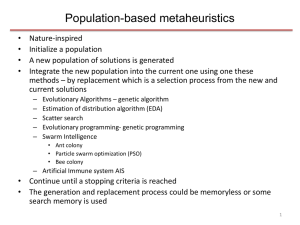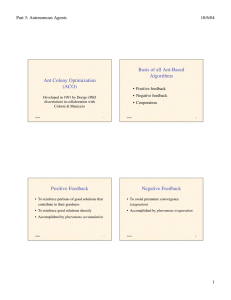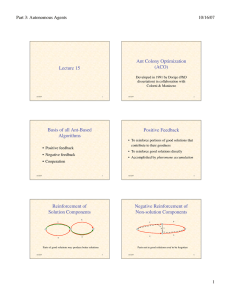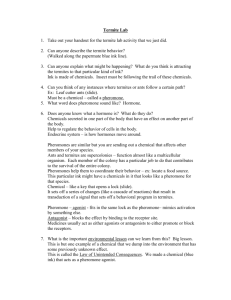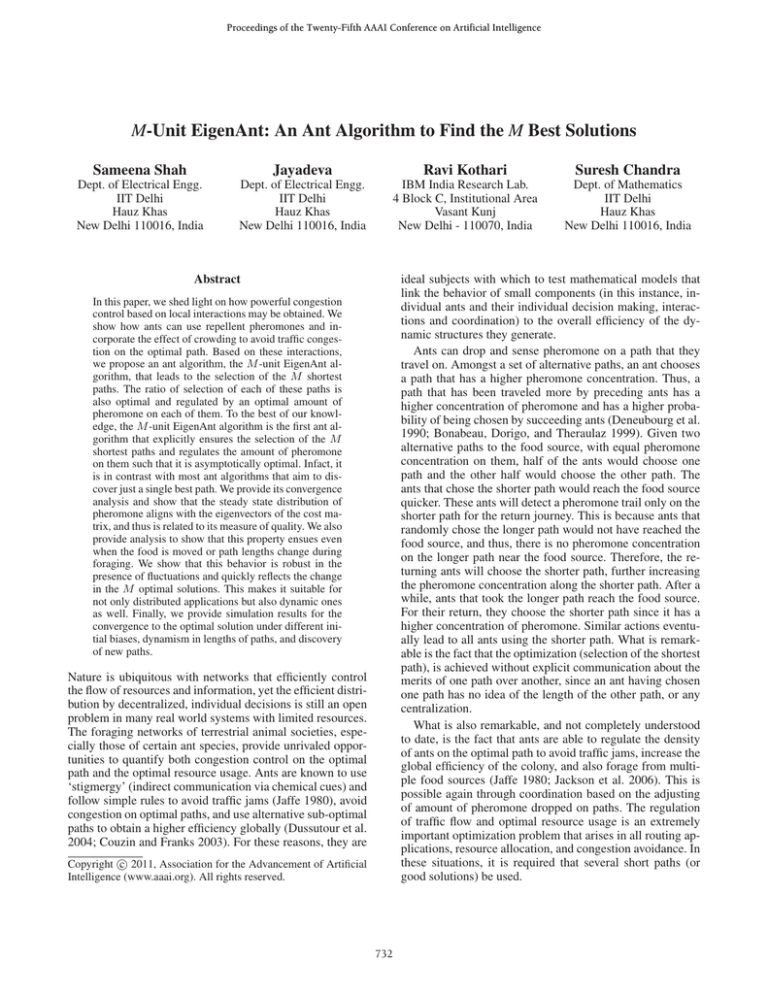
Proceedings of the Twenty-Fifth AAAI Conference on Artificial Intelligence
M-Unit EigenAnt: An Ant Algorithm to Find the M Best Solutions
Sameena Shah
Jayadeva
Ravi Kothari
Suresh Chandra
Dept. of Electrical Engg.
IIT Delhi
Hauz Khas
New Delhi 110016, India
Dept. of Electrical Engg.
IIT Delhi
Hauz Khas
New Delhi 110016, India
IBM India Research Lab.
4 Block C, Institutional Area
Vasant Kunj
New Delhi - 110070, India
Dept. of Mathematics
IIT Delhi
Hauz Khas
New Delhi 110016, India
ideal subjects with which to test mathematical models that
link the behavior of small components (in this instance, individual ants and their individual decision making, interactions and coordination) to the overall efficiency of the dynamic structures they generate.
Ants can drop and sense pheromone on a path that they
travel on. Amongst a set of alternative paths, an ant chooses
a path that has a higher pheromone concentration. Thus, a
path that has been traveled more by preceding ants has a
higher concentration of pheromone and has a higher probability of being chosen by succeeding ants (Deneubourg et al.
1990; Bonabeau, Dorigo, and Theraulaz 1999). Given two
alternative paths to the food source, with equal pheromone
concentration on them, half of the ants would choose one
path and the other half would choose the other path. The
ants that chose the shorter path would reach the food source
quicker. These ants will detect a pheromone trail only on the
shorter path for the return journey. This is because ants that
randomly chose the longer path would not have reached the
food source, and thus, there is no pheromone concentration
on the longer path near the food source. Therefore, the returning ants will choose the shorter path, further increasing
the pheromone concentration along the shorter path. After a
while, ants that took the longer path reach the food source.
For their return, they choose the shorter path since it has a
higher concentration of pheromone. Similar actions eventually lead to all ants using the shorter path. What is remarkable is the fact that the optimization (selection of the shortest
path), is achieved without explicit communication about the
merits of one path over another, since an ant having chosen
one path has no idea of the length of the other path, or any
centralization.
What is also remarkable, and not completely understood
to date, is the fact that ants are able to regulate the density
of ants on the optimal path to avoid traffic jams, increase the
global efficiency of the colony, and also forage from multiple food sources (Jaffe 1980; Jackson et al. 2006). This is
possible again through coordination based on the adjusting
of amount of pheromone dropped on paths. The regulation
of traffic flow and optimal resource usage is an extremely
important optimization problem that arises in all routing applications, resource allocation, and congestion avoidance. In
these situations, it is required that several short paths (or
good solutions) be used.
Abstract
In this paper, we shed light on how powerful congestion
control based on local interactions may be obtained. We
show how ants can use repellent pheromones and incorporate the effect of crowding to avoid traffic congestion on the optimal path. Based on these interactions,
we propose an ant algorithm, the M -unit EigenAnt algorithm, that leads to the selection of the M shortest
paths. The ratio of selection of each of these paths is
also optimal and regulated by an optimal amount of
pheromone on each of them. To the best of our knowledge, the M -unit EigenAnt algorithm is the first ant algorithm that explicitly ensures the selection of the M
shortest paths and regulates the amount of pheromone
on them such that it is asymptotically optimal. Infact, it
is in contrast with most ant algorithms that aim to discover just a single best path. We provide its convergence
analysis and show that the steady state distribution of
pheromone aligns with the eigenvectors of the cost matrix, and thus is related to its measure of quality. We also
provide analysis to show that this property ensues even
when the food is moved or path lengths change during
foraging. We show that this behavior is robust in the
presence of fluctuations and quickly reflects the change
in the M optimal solutions. This makes it suitable for
not only distributed applications but also dynamic ones
as well. Finally, we provide simulation results for the
convergence to the optimal solution under different initial biases, dynamism in lengths of paths, and discovery
of new paths.
Nature is ubiquitous with networks that efficiently control
the flow of resources and information, yet the efficient distribution by decentralized, individual decisions is still an open
problem in many real world systems with limited resources.
The foraging networks of terrestrial animal societies, especially those of certain ant species, provide unrivaled opportunities to quantify both congestion control on the optimal
path and the optimal resource usage. Ants are known to use
‘stigmergy’ (indirect communication via chemical cues) and
follow simple rules to avoid traffic jams (Jaffe 1980), avoid
congestion on optimal paths, and use alternative sub-optimal
paths to obtain a higher efficiency globally (Dussutour et al.
2004; Couzin and Franks 2003). For these reasons, they are
c 2011, Association for the Advancement of Artificial
Copyright Intelligence (www.aaai.org). All rights reserved.
732
In this paper, we shed light on how powerful congestion
control based on local interactions may be obtained. We
show how ants can use repellent pheromones and incorporate the effect of crowding to avoid traffic congestion on the
optimal path. Based on these interactions, we propose an ant
algorithm to be named, the M -unit EigenAnt algorithm, that
leads to the selection of the M shortest paths. The distribution of number of ants selecting each of these paths is optimal because it is proportional to its shortness (or any measure of quality). We provide convergence analysis to prove
that the steady state distribution of pheromone on each path
is related to its measure of quality.
We begin with describing the biological motivations behind our pheromone update rule. We proceed to describe the
algorithm and provide its convergence analysis and properties. We also present simulation results to verify the convergence properties of the algorithm under different conditions
that lead to stagnation and premature convergence to nonoptimal solutions. Finally we conclude with some observations.
lution converged to.
Some of these mechanisms include, introducing a minimum amount of pheromone that a path will always have,
hence avoiding situations in which the probability of choosing of any path (which could be optimal) becomes zero (Ant
Colony System (ACS) (Dorigo and Gambardella 1997)).
Some algorithms like MaxMin Ant System (Stützle and
Hoos 2000) fix the maximum amount of pheromone that can
be dropped on a path. These modifications cause ACS and
MMAS to be amongst one of the best performing heuristics
(Dorigo and Blum 2005) in practice, however, they do not
ensure convergence to the optimal solution. Another commonly used strategy is to introduce negative feedback in the
form of evaporation (Dorigo, Maniezzo, and Colorni 1996).
Evaporation makes it difficult to maintain pheromone trails
on longer paths and improves the solution quality. However,
there are theoretical limits to the amount of initial bias that
can be reverted using these approaches (Shah et al. 2010).
In this paper, we use a negative feedback mechanism
that is based on the concept of ‘repellent pheromones’
dropped by ants in trail formation. Several biological studies (Robinson, Ratnieks, and Holcombe 2008; Jaffe 1980;
Jackson et al. 2006; Dussutour et al. 2004) have reported a
key role of repellent pheromones in governing trail formation. Jaffe (Jaffe 1980) reported a decrease in the recruitment effort at increasing ant densities on the trail. This produced more efficient recruitment and was attributed to the
use of repellent pheromones. Despite the biological motivations, its use in ACO algorithms and applications has been
mostly ignored. In this paper, we show the use of repellent pheromones in congestion control and selection of the
M shortest paths. Note that repellent pheromone is dropped
only on the chosen path and hence is different from an evaporative removal that affects all paths. We introduce a term
−α Ci in the model, to incorporate the effect of repellent
pheromone.
The amount of trail-pheromone is released in accordance
with the quality of the food (Jaffe 1980) and the concentration of pheromone already present on the trail. In our model,
we assume that the additional pheromone (di ) deposited at
the nest end of the i-th path, laid by a returning ant, is proportional to f (li ), where f (·) is any monotonically decreasing function. This term can also be justified in the context
of the physiology of ant’s pheromone glands (Bossert and
Wilson 1963).
We term a set of visits by ants from the nest to the food
source, and back, as an epoch. Putting all the assumptions together, we can describe the working of the model as follows:
In an epoch, CVi ants choose the i-th path. These ants deposit
pheromone βf (li ) or βdi , per unit length. Hence, the total
pheromone deposited on the i-th path near the food source
because of CVi ants having chosen it, will be βdi CVi . Negative feedback results in removal of αCi pheromone from the
amount deposited.
Analytically, we obtain the rule for change in the concentration of pheromone on the i-th path at the t-th epoch of the
form:
Ct
(1)
Cit+1 = Cit − αCit + βdi it .
V
Biological Motivations
Let us assume that there are N alternative paths available to
a colony of ants. We denote the distribution of pheromone
concentration by the vector C. The i-th component of C,
denoted by Ci , represents the amount of pheromone on
the i-th path. We denote the total pheromone concentraN
tion at the food source by V , that is, V =
i=1 Ci . The
length of the i-th path is denoted by li . It is known that the
likelihood of an ant picking the i-th path is a function of
Ci
et al. 1990; Sumpter and Beekman 2003),
V (Deneubourg
N
where V = i=1 Ci . Once an ant chooses the i-th path, it
drops di amount of pheromone on it. We use D to represent
a diagonal matrix whose elements are the diagonal elements
di . This matrix represents the cost matrix of the problem.
Many Ant Colony Optimization (ACO) algorithms are
based only this positive reinforcement based selection of
the shortest path model. However, if there is more initial
pheromone concentration on the longer path, unlike the case
described in the previous section, it has been proven that
only positive reinforcement cannot lead to the selection of
shortest path. Consider the situation when a shorter path
is discovered after the discovery of a long path. In that
situation, the longer path would have a large build-up of
pheromone before the shorter path is discovered on account
of ants having used it. Thus, it would continue to be preferred over the recently discovered shorter path (Shah et al.
2008). The quick returns on the shorter path can revert only
some of the initial bias on the longer path, beyond which a
longer path will continue to get reinforced despite a shorter
path having been discovered (Shah et al. 2010). Thus, beyond this limit, it becomes necessary to introduce some
mechanism to bring the system out of the premature convergence to a non-optimal path. Not only should any ACO
algorithm be able to revert the initial bias on sub-optimal
paths, but also it should be Plastic enough to allow the movement of trail to a newly discovered optimal solution. The
efficiency of these mechanisms determines the quality of so-
733
ΔCk,1 = 0, for each path k = 1, 2, . . . , N .
There are several other microscopic interactions that
come into play while recruitment, for example, communications may involve stroking, gasping, antenna movements,
and streaking of chemicals. However, in this work, our aim
is to show at a macroscopic level how the local interactions
based on stigmergy can lead to congestion control and optimal traffic distribution and we ignore these and several other
microscopic interactions. In the next section, we show how
we can develop this model such that it leads to the selection of the M shortest paths asymptotically and also optimal
distribution of pheromone on them.
Ck,1
=0.
(3)
V1
Representing Ck,1 where k = 1, 2, . . . , N by a variable
x and using D to denote a diagonal matrix whose entries
di = f (li ), we get,
ΔCk,1 = −αCk,1 + βdk
(α V1 )x = βDx .
In other words, the pheromone concentration vector x is an
eigenvector of the diagonal matrix D, and we may write
Dx = λx ,
M -Unit EigenAnt Algorithm
j
k=1
Ci,k t + β di
Ci,j t
,
Vjt
(5)
where, λ represents the eigenvalues.
Since D is a diagonal matrix, its eigenvectors are unit vectors, each corresponding to a distinct path. Hence, at steady
state, the expected pheromone distribution is one in which
all the deposited pheromone is concentrated on one path.
Thus, corresponding to an index j there will only be one
path i that will have a non-zero component ci,j .
If the i-th eigenvalue is denoted by λi , then we note that
N
α
λi = di =
Ck,1
β
k=1
N
β
Ck,1 = di . .
⇒
(6)
α
In this section, we present our M -unit EigenAnt algorithm1 .
The algorithm is parameterized by M that allows the maintaining of trail on the M best solutions, which is selected
depending on the application at hand.
Since the goal is to lead to the selection of M paths, we
use C to denote a pheromone matrix instead of a vector.
Note that the use of a matrix may yield this algorithm implausible but the association of a vector with each path is
a common practice in artificial ant algorithms. The order of
the matrix C is N ×M where N denotes the number of paths
and M denotes the cardinality of the set of optimal solutions
required. The alternative paths need not be disjoint paths and
there may be shared edges between them. In the pheromone
matrix C, a component Ci,j denotes the pheromone on the
i-th path while j is used as an index to differentiate between
the M best solutions.
For the M -unit EigenAnt rule, the change in concentration at the t-th epoch for pheromone on the i-th path w.r.t
the j-th winner, is determined as
ΔCi,j t = −α
(4)
k=1
Equation (6) indicates that the total pheromone deposited
on the path is bounded at steady state. This is sensible in that
as long as a food source is available, ant trails should continue getting reinforced. The total pheromone does not grow
out of bound because of the steady state repellent pheromone
amount deposition that counters it.
Any normalized eigenvector of D would satisfy equation
(5), but we need to show that the only stable eigenvector
would be the one corresponding to the largest eigenvalue.
This corresponds to the shortest path because di = f (li ) is
a monotonically decreasing function of li .
Let the eigenvector corresponding to eigenvalue λi be denoted by ui , and suppose that the pheromone distribution is
given by x = ui , that is, the pheromone is concentrated on
the i-th path. At steady state, we have
α
α
(7)
Dui = λi ui = V1 ui = (eT ui )ui ,
β
β
(2)
N
where, Vjt = p=1 Cp,j t . If a path i is the j − th optimal
solution, and j ≤ M then only Ci,j will be non-zero and all
other components of Ci will be zero asymptotically.
The total number of non-zero components of C at the
steady state, is determined by the parameter M . In the next
section, we show that for a particular choice of M , one can
obtain the M most optimal solutions. The components of C
corresponding to the remaining N − M solutions will go to
zero. Also, the pheromone distribution on the M optimal solutions will be inversely proportional to their cost, while the
pheromone distribution on the remaining N − M paths will
go to zero.
where, eT = [1, 1, . . . , 1]N .
Suppose that there is a perturbation of ε around the steady
state value of x, that is, let x be perturbed to x = ui + ε.
Consider the value of
V1 (Δx + Δε) = V1 Δε = βD(x + ε) − αV1 (x + ε) .
(8)
Inserting x = ui , we obtain
Convergence Analysis
We begin with determining which path is asymptotically selected as the most optimal solution, that is, which i-th path
is chosen for the corresponding index j = 1. For the system of equation (2), an equilibrium point is characterized by
βD(ui + ε) − α[eT (ui + ε)](ui + ε).
(9)
Simplifying the above, we get
[βDui − α(eT ui )ui ] + βDε − α(eT ε)ui
1
The algorithm is motivated by Sanger’s rule (Sanger 1989) and
Oja’s M -unit rule. Similarly, we name it the M -unit EigenAnt rule
− α(eT ui )ε − α(eT ε)ε .
734
(10)
The term within square parenthesis is zero due to (7). The
last term, α(eT ε)ε, is O(ε2 ), and thus negligible. Thus, we
can write (10) as,
βDε − α(eT ε)ui − α(eT ui )ε .
paths. Another goal of this experiment was also to validate
whether ants are able to optimally regulate the amount of
pheromone on all available paths and hence lead to an optimal distribution of ants on the available paths. To verify this
we chose M = N .
We take a network of 10 alternative paths with lengths increasing from 1 to 10. In each time step, only one ant took a
decision. Pheromone trail on each path was tracked and updated according to equation (2) only during the return journey of ants.
Figure 1 shows the change in the pheromone distribution on all the paths during the simulation. Each path is indexed by its length, thus path L4 was a path of length 4.
As seen in the figure, path L10 , the path of length 10, was
initially given the highest amount of pheromone, of magnitude 1. The shortest path, path L1 was initially given the
least amount of pheromone of 0.1 units. As seen in the figure, ants quickly recover from the biased situation and the
pheromone concentrations on the short paths rise while that
on the long paths decrease. It is also observed that at steady
the concentration of pheromone on each path is in decreasing order of the lengths of the paths. It is also related to the
eigenvalue of each path, which is related to the path length
for the algorithm.
For example, the set of lengths l = [1 2 3 4 5 6 7 8 9
10], the set of eigenvalues of the corresponding D matrix
with f (li ) = 1/li , are [1.00000 0.50000 0.33333 0.25000
0.20000 0.16667 0.14286 0.12500 0.11111 0.10000]. The
sum
of these eigenvalues is 2.9290 and the sum of lengths,
l = 55. According to equation (13), we expect the asymptotic distribution of pheromone on paths to be proportional
to [ 18.7780 9.3890 6.2593 4.6945 3.7556 3.1297 2.6826
2.3472 2.0864 1.8778]. As seen in the figure, the asymptotic
pheromone distribution for all non-optimal paths is not zero,
rather it is proportional to the respective eigenvalues.
Thus, it can be summarized that the algorithm leads to the
selection of the M best solutions and regulates the quantity
of pheromone on each solution such that its magnitude is
proportional to the quality of each solution, even when large
initial biases are present on sub-optimal paths.
(11)
We now examine the component of Δε in the direction
of another eigenvector, say uj . We have (uj )T V1 Δε as,
= (uj )T βDε − α(eT ε)(uj )T ui − α(eT ui )(uj )T ε
= εT Duj − αδij (eT ε) − di (uj )T ε
= (dj − di )(uj )T ε − αδij (eT ε),
(12)
where, δij is the Kronecker delta function.
Equation (12) indicates that a perturbation of +ε will have
a growing component in the direction of a different eigenvector uj if (dj > di ). Such an eigenvector always exists unless ui corresponds to the largest di . In other words, x converges to the eigenvector corresponding to the largest eigenvalue; when this happens, the first term is zero or negative
for all j, and the second term is negative. Hence, following
any perturbation +ε, the pheromone vector changes in the
opposite direction to restore x to its earlier value. Since, the
largest eigenvalue corresponds to the shortest path, the first
winner, corresponding to j = 1 will converge to the shortest
path. Note that not only does the algorithm reach convergence to the optimal solution irrespective of the initial conditions on the pheromones on paths but also under perturbations. If a new path with a larger eigenvalue will emerge, or
a previous food source disappears, the pheromone concentration will adapt and align according to the new conditions.
Using induction on the lines of Sanger’s rule (Sanger
1989) it can be shown that if the first j − 1 columns of C
converge to the first j − 1 eigenvectors (or the j − 1 most
optimal solutions), then the j column will also converge to
the j-th eigenvector.
Also, it turns out that in the limit j = N , the asymptotic
pheromone concentration on the j-th path is proportional to
N
1
p=1 lp
,
(13)
N
lj
p=1 λp
Validation under congestion control and dynamism
in path lengths
where λp represents the p-th eigenvalue of D.
In the next section, we validate the convergence properties of our algorithm under different conditions that usually
inhibit the convergence of ant algorithms to the optimal solution.
We elucidate the embedding of an optimization problem by
application to dynamic routing. Suppose a network exists,
where packets have to be routed from a source to a destination point and several alternate routes or solutions exist that
can be used for routing the packets. The goal is to choose
the path with the minimum travel time to route the packets.
The travel time on each of these routes is governed by several factors like physical length of the network, the speed of
the intermediate hubs, the traffic on the paths, any built up
of queues etc. In dynamic routing, new paths may arrive and
old paths may leave (hub going down), lengths of the paths
may vary drastically because of built up of queues etc.
The traversal of an ant on a path is analogous to the sending of a packet on the chosen link. The return of the ant is
similar to the receipt of an acknowledgement. We determine
the cost ci of a link by noting the difference in time between
Experimental Results
Validation in presence of large bias on sub-optimal
paths
The presence of initial bias on suboptimal paths is a critical
reason for inability of artificial ant algorithms to converge
to the optimal path. To make it difficult for the algorithm
to reach the optimal solutions, we initialized the pheromone
concentration on each path to be proportional to its length.
This implies that initially ants were purposely misguided towards longer paths, thus making it difficult for them to discover and maintain optimal pheromone magnitude on all the
735
M-unit update rule
Pheromone concentration on paths
2
L1
L2
L3
L4
L5
L6
L7
L8
L9
L10
1.5
1
0.5
0
500
Iteration
1500
1000
Figure 1: Change in the pheromone distribution on 10 paths
of lengths ranging from 1 to 10, and initial biases inversely
proportional to their lengths, using the M -unit EigenAnt algorithm
Discussion
In this section, we discuss the individual roles of positive
and repellent pheromones. Consider for example two paths
of lengths 1 and 2 units with initial pheromone 1 and 10
units on them respectively. Now consider the use of only
positive reinforcement. In this case additional pheromone
dropped on the longer and shorter path is proportional
to β.f (2).(10/11) and β.f (1).(1/11) respectively. Taking
f () = 1/li in equation 1, we get β.(5/11) on the longer
path and β/11 on the shorter path. Since the initial bias of 10
units on the longer path is more than that on the shorter, more
ants will initially choose the longer path. Moreover, each ant
will drop a greater amount of pheromone, that is, β.(5/11)
on the longer path in contrast to β/11 being dropped on
the shorter. This reinforces the longer path which was already “rich” in pheromone “richer” and hence an eventual
convergence to the longer path. In this case, the possibility of the shorter path emerging as a winner is probable
only if the initial concentration on longer path was up to
2 units. Similarly, in general for a chosen f , there exists
an upper limit on amount of initial pheromone that can be
reversed by positive reinforcement only (Shah et al. 2008;
2010; Dorigo and Gambardella 1997; Bonabeau, Dorigo,
and Theraulaz 1999). The amount of repellent pheromone
dropped on the chosen path is proportional to the total
pheromone experienced on that path. Repellent pheromones
are responsible for eliminating the initial pheromone bias on
paths and positive reinforcement assigns more pheromone to
better paths.
The parameters α and β weigh the positive and negative
feedback terms. It is necessary to keep the value of α lesser
than β to reach steady state and build consensus about good
paths. Also, if the initial pheromone concentrations on suboptimal paths are very high then α should not be very low
compared to β because enough pheromone may not be removed from the sub-optimal paths quickly enough. In other
Dynamic Routing using the proposed rule
1
L1
Probability of choosing the paths
L2
0.8
L3
L4
L5
0.6
0.4
0.2
0
500
sending a packet, and receiving its acknowledgement. No
additional packets need to be added to the network.
For illustration, we assume that there are 5 distinct
paths. Ants choose paths probabilistically according to their
pheromone concentrations and update the concentration
only on the links that they choose during their backward
journey. Figure 2 shows the result of this experiment. We
introduced some dynamism after few intervals. Initially all
paths were initialized with the same amount of pheromone
and path L1 was the shortest path. Therefore, as seen in the
figure the concentration quickly builds up on path 1. After
a trail had established on it, it suddenly went down at iteration 50. This means that its cost became a very large number.
Ants quickly adapted to the situation and started using path
2, the new optimal path. Next, we introduced a large amount
of traffic on path 2, such that it could not handle that much
traffic and packets started experiencing delay on it. In this
situation, path L3 starts getting more reinforcement to adapt
with the congestion on path L2. This reduced the traffic on
path L2, because of which, at iteration 600, it again became
the optimal path with cost = 2. We introduced similar traffic
cycles to observe the continual adaptation of the system.
1000
Iteration
Figure 2: For the problem of dynamically routing packets
over a network, this plot shows the change in choosing probability for a random run. The dynamism is the decision making, going down of links and change of lengths of the links.
The update rule used is R1 with f (li ) = 1/li3 , α = 1,
β = 1. Initially, link L1 was the shortest but it went down.
Thereafter, links L2 was periodically introduced heavy traffic, where the algorithm started rerouting most of the traffic to the next best path, path L3 and the congestion on L2
cleared. As seen in the plot, the pheromone concentration
reflects the fact that the update rule was able to adapt with
the situation.
736
cases, the ratio β/α simply acts as a scaling factor in the
steady state concentrations (cf. equation 6).
Bossert, W. H., and Wilson, E. 1963. The analysis of olfactory communication among animals. Journal of Theoretical
Biology 5:443–469.
Couzin, I., and Franks, N. 2003. Self-organized lane formation and optimized traffic flow in army ants. In Proceedings
Royal Society of London B, volume 270, 139–146.
Deneubourg, J.-L.; Aron, S.; Goss, S.; and Pasteels, J.-M.
1990. The self-organizing exploratory pattern of the argentine ant. Journal of Insect Behaviour 3:159–168.
Dorigo, M., and Blum, C. 2005. Ant colony optimization
theory:A survey. Theoretical Computer Science 344:243–
278.
Dorigo, M., and Gambardella, L. 1997. Ant Colony System:
A Cooperative learning approach to the Traveling Salesman
Problem. IEEE Transactions on Evolutionary Computation
1(1):53–66.
Dorigo, M.; Maniezzo, V.; and Colorni, A. 1996. Ant System: Optimization by a colony of cooperating agents. IEEE
Transactions Systems, Man, Cybernetics-Part B 26(1):29–
41.
Dussutour, A.; Fourcassi, V.; Helbing, D.; and Deneubourg,
J.-L. 2004. Optimal traffic organization in ants under
crowded condition. Nature.
Jackson, D.; Martin, S.; Holcombe, M.; and Ratnieks, F.
2006. Longevity and detection of persistent foraging trails
in Pharaoh’s ants, Monomorium pharaonis (l.). Animal Behaviour 71:351–359.
Jaffe, K. 1980. Theoretical analysis of the communication
system for chemical mass recruitment in ants. Journal of
Theoretical Biology 84:589–609.
Robinson, E.; Ratnieks, F.; and Holcombe, M. 2008. An
agent based model to investigate the roles of attractive and
repellent pheromones in ant decision making during foraging. Journal of Theoretical Biology 255:250–258.
Sanger, T. 1989. Optimal unsupervised learning in a singlelayer linear feedforward neural network. Neural Networks
2(6):459.
Shah, S.; Kothari, R.; Jayadeva; and Chandra, S. 2008.
Mathematical modeling and convergence analysis of trail
formation. In Proceedings of the Twenty-Third AAAI Conference on Artificial Intelligence, 170–175.
Shah, S.; Kothari, R.; Jayadeva; and Chandra, S. 2010. Trail
formation in ants: A generalized Polya Urn process. Swarm
Intelligence 4(2):145–171.
Stützle, T., and Hoos, H. 2000. MAX-MIN Ant System.
Future Generation Computer Systems 16(8):889–914.
Sumpter, D., and Beekman, M. 2003. From non-linearity
to optimality: pheromone trail foraging by ants. Animal Behaviour 66:273–280.
Conclusion
Ants are known to use indirect communication via different types of pheromones and follow simple rules. They use
only distributed interactions and local information, and distributed decision making. Despite the simplicity, this coordination leads to self-organization and emergence of trails
that avoid building of traffic jams, avoid congestion on optimal paths, and use alternative sub-optimal paths and lane
formation to obtain a higher global efficiency. For these reasons, they provide valuable insight to self-organization studies that relate simple microscopic interactions with complex
emergent macroscopic behavior. In this paper, we shed light
on how powerful congestion control based on local interactions may be obtained. We showed how ants can use repellent pheromones and incorporate the effect of crowding to
avoid traffic congestion on the optimal path.
Based on these interactions, we proposed an ant algorithm, that leads to the selection of the M shortest paths. To
the best of our knowledge, the M -unit EigenAnt algorithm
is the first algorithm that explicitly ensures this selection.
Infact, this algorithm is in contrast with most ant algorithms
that aim to discover just a single best path. Our algorithm
should be beneficial in applications that involve any form
of congestion control or routing. The algorithm can be also
be used to solve a seemingly different problem of foraging
from multiple food sources (that is, the optimal simultaneous usage of available resources). If the measure of quality
(which is imbibed in the cost matrix itself) incorporates the
information of goodness of different resources, then the algorithm is directly applicable.
The distribution of number of ants selecting each of these
paths was shown to be optimal in the sense that it is proportional to its shortness (or any measure of quality). We also
provided convergence analysis for the steady state distribution of pheromone on all the paths. The steady state distribution was shown to align with the eigenvectors of the cost
matrix, and thus related it to its measure of quality.
We also provided perturbation analysis to show that this
property ensues even when the food is moved or path lengths
change during foraging. If a new better path emerges, then
the colony adjusts the proportion of trails according to the
new path lengths. We showed that this behavior is robust in
the presence of fluctuations and quickly reflects the change
in the M optimal solutions. This makes it suitable for not
only distributed applications but also dynamic ones as well.
Finally, we supported our claims by simulation results that
confirm convergence to the optimal solution under different
initial biases, dynamism in lengths of paths, and discovery
of new paths.
References
Bonabeau, E.; Dorigo, M.; and Theraulaz, G. 1999. Swarm
Intelligence:from Natural to Artificial Systems. Oxford University Press US.
737

